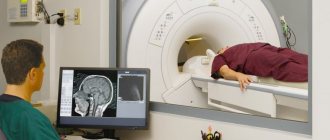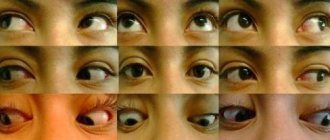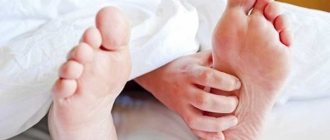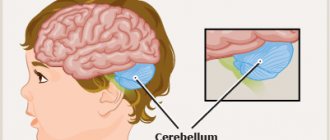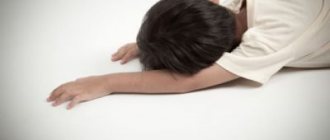Forms
Sensitive ataxia is divided into:
- Static, in which the main manifestation of the pathology is a violation of maintaining posture. Romberg's posture with his eyes closed becomes even more unstable.
- Dynamic, in which disturbances manifest themselves mainly during movement.
Based on the clinical picture, we distinguish:
- A mild form of sensitive ataxia, which is observed with isolated damage to the spinocerebellar tract. With this form, a violation of deep sensitivity does not manifest itself and the disturbance of coordination of movements and gait is expressed to a moderate degree.
- Moderately severe form, in which the patient, as a result of decreased tone of the flexor and extensor muscles, is unable to fasten buttons, etc. Due to a decrease in deep reflexes, the patient has no sense of support, so he needs visual control of movements when walking. In this case, the gait acquires a “stamping” character (with each step, the legs bend excessively and forcefully fall to the surface, as the person experiences a sensation of “sinking” of the legs).
- A severe form in which the patient is unable to stand or walk.
In the presence of damage to the deep sensory pathways, sensitive ataxia can be detected:
- unilateral, which is detected when the lesion is localized in the thalamus or in the brain stem on the side opposite to the lesion;
- bilateral, which is detected when the lesion is localized in the area of the intersection of the medial loop.
Types of pathological condition
There are 3 types of axonopathy, which differ in the mechanism of development, severity of the clinical picture and etiological factor.
- Type 1 disorder refers to acute degenerative processes; the disease occurs when the body is seriously poisoned.
- The subacute pathological process is characterized by type 2 , which is caused by metabolic disorders. Often, this is diabetes mellitus, gout, etc.
- Peripheral process degeneration type 3 develops more slowly than other variants of the disease. This type of disease is often observed in people with weakened immune systems and those suffering from alcoholism.
Reasons for development
Sensitive ataxia occurs when:
- The posterior cords of the spinal cord are the Gaulle fasciculus and the sphenoid fasciculus, which are the ascending tracts of the spinal cord. Such lesions are most common in sensitive ataxia. Usually occur due to injury, which is accompanied by a sharp flexion of the spine.
- Peripheral nerves. The lesion occurs due to axonopathy (damage to the axons of nerve fibers), segmental demyelination (myelinopathy), Wallerian degeneration (develops with peripheral nerve injury or ischemia of the nerve trunk).
- Posterior spinal roots (in case of injury, compression, etc.).
- The medial lemniscus, located in the brain stem. The medial lemniscus is part of the pathway that carries impulses for the muscular-articular sense and touch of proprioceptive sensitivity (bulbo-thalamic tract).
- The thalamus, which, as a kind of collector of all types of sensitivity, occupies an important place in the implementation of unconditioned reflexes.
Sometimes sensory ataxia is caused by lesions of the parietal lobe on the contralateral side.
Sensitive ataxia is caused by diseases such as:
- Tabes dorsalis (is a form of late (tertiary) neurosyphilis). With this disease, the pathological process that begins in the spinal nerves gradually spreads to the ganglia and substance of the spinal cord, affecting mainly its posterior columns. Signs of sensitive ataxia are detected at the 2nd, ataxic stage of the disease. Hypotension also joins the symptoms of the disease at this stage.
- Funicular myelosis, which is manifested by degeneration of the posterior and lateral cords of the spinal cord due to prolonged deficiency of vitamin B12, as well as in folate-deficiency anemia.
- Some forms of polyneuropathy (Guillain-Barré syndrome, chronic inflammatory demyelinating polyneuropathy, diphtheria neuropathy, metachromatic leukodystrophy, Refsum and Crabbe disease, arsenic polyneuropathy, etc.).
- Vascular disorders (ischemia of the cephalic spinal artery, etc.).
- Brain tumors.
Sensitive ataxia is also detected in Friedreich's disease, a rare disease transmitted in an autosomal recessive manner. Impaired coordination of movements is accompanied by damage to the heart muscle and other organs and systems.
Peroneal nerve neuropathy
In 2/3 of cases, neuritis is a secondary disease of traumatic origin, only a third of cases are caused by nerve pathology itself. The most common causes of the disease by group:
- Traumatic . All kinds of injuries to the foot and lower leg: fractures, bruises due to falls or blows, dislocations, tendon injuries, sprains. Injuries to the knee and the outer part of the leg, where the nerve lies in close proximity to the surface of the skin, are especially dangerous.
- Compression . Causes caused by nerve compression.
- Superior tunnel syndrome (compression at the top of the nerve path) occurs in the area of the fibula under the influence of the biceps muscle. It is usually provoked by prolonged squatting in people of relevant professions: vegetable pickers, parquet floor workers, plumbers, etc. Another reason is frequently repeated actions that put pressure on the accumulation of nerve fibers in this area (the work of a fashion model or seamstress), constant sitting in a position with one leg crossed over the other.
- Inferior tunnel syndrome (compression where the nerve passes to the foot). Develops as a result of wearing uncomfortable tight shoes or after placing a cast.
Pathogenesis
Sensitive ataxia is caused by damage to fibers that are part of the peripheral nerves, dorsal roots and posterior columns of the spinal cord, as well as the medial lemniscus. These fibers carry proprioceptive impulses (contain information about the position of body parts and their movement) from the receptors to the cerebral cortex.
Articular-muscular sensation is provided by the receptor apparatus, which is represented by Pacinian corpuscles (non-encapsulated nerve endings located in the joint capsules, ligaments, muscles and periosteum). Impulses from the receptors travel along the processes of first-order sensory neurons (thick myelinated type A fibers), which enter the posterior horn of the spinal cord, and then, without crossing, into the posterior columns.
Proprioceptive information is transmitted from the lower extremities through the medially located Gaulle's bundle (thin fasciculus), and from the upper extremities through the lateral Burdach's fasciculus (sphenoid fasciculus).
The fibers running as part of these pathways form synapses with second-order sensory neurons, which form the nuclei of the thin and wedge-shaped fasciculi in the lower part of the medulla oblongata.
The processes of second-order neurons cross, after which, as part of the medial loop, they rise to the ventral posterior nucleus of the thalamus. In the ventral posterior nucleus of the thalamus there are third-order sensory neurons associated with the parietal lobe cortex.
The transmission of nerve impulses that provide sensitivity to the limbs is carried out by the dorsal roots of the spinal cord, and nerve fibers located in the posterior part of the spine are responsible for sensory perception and pain.
Damage to the dorsal roots leads to the disappearance of sensitivity in the area of the skin innervated by the nerve fibers of these roots, a decrease or loss of tendon reflexes, but the ability to perform motor functions is preserved.
As a result of damage to any part of the ascending tract, the spinal cord is not able to transmit information about the position of body parts to the brain, so coordination of movements is impaired.
Polyneuropathies and lesions of the posterior columns usually lead to symmetrical impairment of walking and movements of the lower extremities with normal or minor impairment of movements of the upper extremities.
Prevention of peroneal nerve diseases
The following will help reduce the risk of nerve damage:
- proper nutrition. Will allow you to avoid excess weight and the associated additional stress on your legs;
- moderate regular physical activity;
- compliance with temperature conditions. Avoid prolonged overheating or hypothermia of the feet;
- compliance with the regimen and recommendations of the attending physician to avoid the consequences of a pinched nerve.
Gradually, motor activity will be restored. You will have to be patient: rehabilitation usually takes a long time.
Ivanova Svetlana
General practitioner of the second category, transfusiologist, 29 years of experience
Diagnosis and treatment of problems with the musculoskeletal system (lower leg) and abdomen.
- pain and discomfort in the abdomen;
- bruises and injuries of the lower leg;
- cough, chest pain;
- acute respiratory infections, ARVI;
- food poisoning;
- cold;
- runny nose;
- general malaise;
- headache;
- aching joints;
- elevated temperature.
- Diploma in the specialty “General Medicine (Treatment and Prevention)”, Chuvash State University named after. I.N. Ulyanova, Faculty of Medicine (1990)
- Internship in the specialty “Selected Issues of Therapy”, Kazan State Medical Academy (1996)
Refresher courses
- “Nephrology issues for therapists”, State Institute for Advanced Training of Physicians named after V.I. Lenin (1995)
- “Therapy”, Kazan State Medical Academy (2001)
- “Transfusiology”, Russian Medical Academy of Postgraduate Education of the Ministry of Health of the Russian Federation (2003)
- “Therapy and Pulmonology”, St. Petersburg Medical Academy of Postgraduate Education of the Federal Agency for Health and Social Development (2006)
- “Transfusiology”, St. Petersburg Medical Academy of Postgraduate Education of the Federal Agency for Health and Social Development (2007)
- “Transfusiology”, Institute for Advanced Medical Studies of the Ministry of Health and Social Development of Chuvashia (2012)
- “Therapy”, Institute for Advanced Medical Studies of the Ministry of Health and Social Development of Chuvashia (2013)
- “Therapy”, Peoples' Friendship University of Russia (2017)
Place of work: MedCenterService clinic on Kurskaya
neuropathy (peroneal) is a type of peripheral neuropathy that affects the lower part of the sciatic nerve, the longest nerve in the body, starting at the fourth vertebra and running down the leg to the foot . In the region of the popliteal nerve, it divides into two branches:
- Tibial nerve (exits to the posterior surface of the popliteus muscle, is responsible for plantar flexion of the foot with the muscles of the lower leg).
- Common peroneal nerve (passes along the tubular bone of the leg):
- Superficial branch (located on the surface of the calf muscle, provides elevation of the outer edge of the foot).
- Deep branch (passes through the peroneus muscle, activates the extensors of the foot and fingers).
Its superficial subcutaneous location on the lateral side of the leg makes the peroneal nerve particularly susceptible to injury or compression, leading to dysfunction and loss of sensation in the foot.
Symptoms
Symptoms of sensory ataxia include:
- instability when walking, which is accompanied by excessive bending of the legs at the hip and knee joints;
- "stamping gait";
- reduction of instability when visual control is turned on.
Intention tremor is not typical for this type of ataxia.
Sensitive ataxia may be accompanied by dynamic coordination disorders of the hands (“postural fixation defects”), in which the lack of visual control over the arms extended in a horizontal position leads to the appearance of slow movements of the arms in different directions (pseudoathetosis) and involuntary movements in the hands and fingers. At the same time, patients are able to hold their limbs in extreme positions of flexion or extension better than in average positions.
First signs
The disease usually begins to develop with damage to thick or thin nerve fibers. Often, axonal polyneuropathy has a distal symmetrical distribution on the hands or feet. Neuropathy most often affects the lower extremities first and then spreads symmetrically up the body. The most common primary symptoms of damage include:
- muscle weakness;
- pain syndrome in the limbs;
- burning;
- crawling sensation;
- numbness of the skin.
Symptoms are most pronounced in the evening and at night.
Diagnostics
Sensitive ataxia is diagnosed based on tests:
- finger-nose and heel-knee tests to identify dysmetria (insufficiently accurate and increased in volume sweeping movements, misses);
- for adiadochokinesis (inability to perform alternating, rapid movements), which include pronation and supination of the hand, flexion and extension of the fingers;
- Romberg (simple).
All tests are performed with both open and closed eyes.
For additional diagnostics that help identify the cause of the pathology, EEG, MRI, EMG and DNA examination are performed.
Treatment
Treatment of sensitive ataxia is aimed at eliminating the factors that caused the pathology. Appointed:
- B vitamins (for funicular myelosis, vitamin B12 is administered intramuscularly at 500-1000 micrograms daily or every other day, and after 5 days the drug is administered once a week at 100 micrograms for 6 months). For the folate-deficient form of funicular myelosis, folic acid is used at a dose of 5-15 milligrams per day.
- Nootropic drugs (Cerebrolysin, amiridine, etc.) for vascular pathology of the brain.
- Immunoglobulin, which is necessary to maintain immunity.
- Riboflavin, which is used in the presence of neoplasms.
- Anticholinesterase drugs, which promote better conduction of excitation in nerve endings and are used in the presence of peripheral neuritis.
Treatment includes a set of gymnastic exercises, which are aimed at reducing incoordination and strengthening muscles. Daily walking of up to 1 km is also recommended.
Features of neuralgia
Neuralgia occurs as a consequence of injury. This could be a severe bruise of the ankle joint, a dislocation or a fracture. Both adults and children are susceptible to pathology. Sometimes it can be a consequence of damage to the peroneal nerve during meniscus surgery.
The main symptoms of the disease:
- increasing the pain threshold, external influences are felt less in the damaged area.
- disturbances affect the functioning of muscles in the area of the nerve ending, and gait changes noticeably.
If the cause of a pinched nerve is injury, complex therapy is required. First, you need to immobilize the injured leg so that the tissues heal properly.
For this, plaster tape is used, which provides fixation and prevents possible re-injury.
If the injury site has already begun to become inflamed, the patient needs to take medications that can relieve pain and swelling. In addition, vitamins, physiotherapy and exercise therapy are needed for pinched peroneal nerves.




